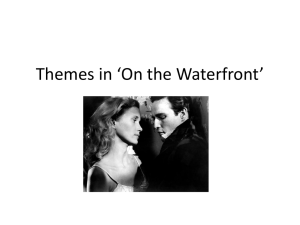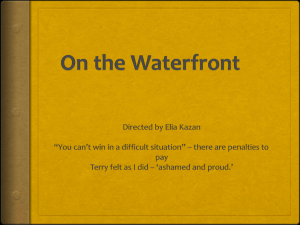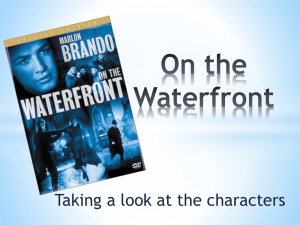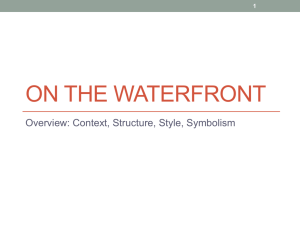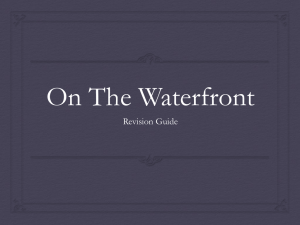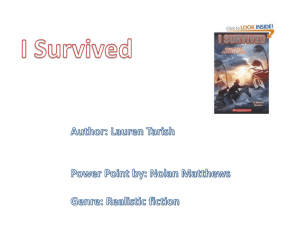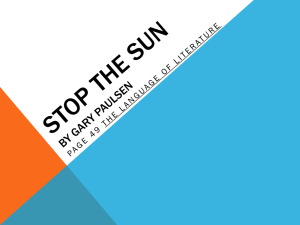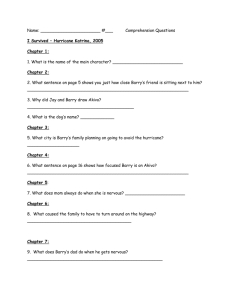OTW SAmple Essay - Year 12 English – Mentone Grammar
advertisement
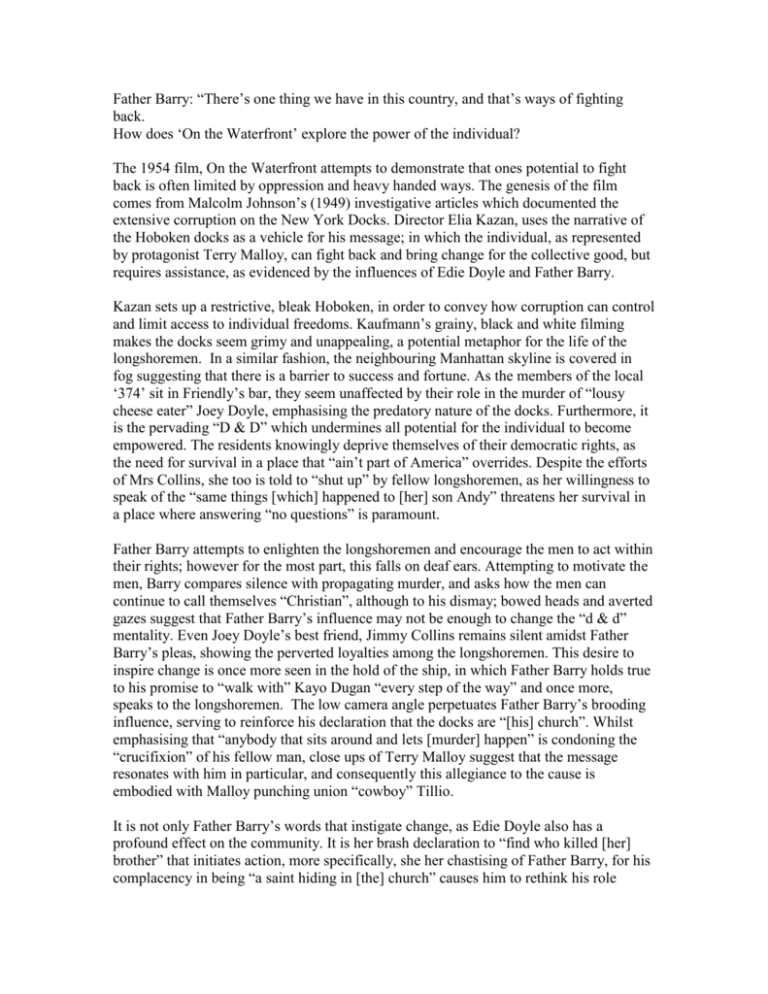
Father Barry: “There’s one thing we have in this country, and that’s ways of fighting back. How does ‘On the Waterfront’ explore the power of the individual? The 1954 film, On the Waterfront attempts to demonstrate that ones potential to fight back is often limited by oppression and heavy handed ways. The genesis of the film comes from Malcolm Johnson’s (1949) investigative articles which documented the extensive corruption on the New York Docks. Director Elia Kazan, uses the narrative of the Hoboken docks as a vehicle for his message; in which the individual, as represented by protagonist Terry Malloy, can fight back and bring change for the collective good, but requires assistance, as evidenced by the influences of Edie Doyle and Father Barry. Kazan sets up a restrictive, bleak Hoboken, in order to convey how corruption can control and limit access to individual freedoms. Kaufmann’s grainy, black and white filming makes the docks seem grimy and unappealing, a potential metaphor for the life of the longshoremen. In a similar fashion, the neighbouring Manhattan skyline is covered in fog suggesting that there is a barrier to success and fortune. As the members of the local ‘374’ sit in Friendly’s bar, they seem unaffected by their role in the murder of “lousy cheese eater” Joey Doyle, emphasising the predatory nature of the docks. Furthermore, it is the pervading “D & D” which undermines all potential for the individual to become empowered. The residents knowingly deprive themselves of their democratic rights, as the need for survival in a place that “ain’t part of America” overrides. Despite the efforts of Mrs Collins, she too is told to “shut up” by fellow longshoremen, as her willingness to speak of the “same things [which] happened to [her] son Andy” threatens her survival in a place where answering “no questions” is paramount. Father Barry attempts to enlighten the longshoremen and encourage the men to act within their rights; however for the most part, this falls on deaf ears. Attempting to motivate the men, Barry compares silence with propagating murder, and asks how the men can continue to call themselves “Christian”, although to his dismay; bowed heads and averted gazes suggest that Father Barry’s influence may not be enough to change the “d & d” mentality. Even Joey Doyle’s best friend, Jimmy Collins remains silent amidst Father Barry’s pleas, showing the perverted loyalties among the longshoremen. This desire to inspire change is once more seen in the hold of the ship, in which Father Barry holds true to his promise to “walk with” Kayo Dugan “every step of the way” and once more, speaks to the longshoremen. The low camera angle perpetuates Father Barry’s brooding influence, serving to reinforce his declaration that the docks are “[his] church”. Whilst emphasising that “anybody that sits around and lets [murder] happen” is condoning the “crucifixion” of his fellow man, close ups of Terry Malloy suggest that the message resonates with him in particular, and consequently this allegiance to the cause is embodied with Malloy punching union “cowboy” Tillio. It is not only Father Barry’s words that instigate change, as Edie Doyle also has a profound effect on the community. It is her brash declaration to “find who killed [her] brother” that initiates action, more specifically, she her chastising of Father Barry, for his complacency in being “a saint hiding in [the] church” causes him to rethink his role within the community and ability to fight back. In Kazan’s production notes, Edie is said to be the “conscience holder” of the film as it is her philosophy that “everybody [should] care about everybody else” that provokes change within the ambivalent Terry Malloy. Malloy, representing the misguided collective, tells Edie to “quit worryin’ about the truth all the time” and it her criticism that he is still a [bum] and needs to do “much, much more” that plays a integral role in his action. Ultimately, Terry demonstrates the power of the individual as he is able to gain the support of the longshoremen in his quest for the truth and fight for “[his] rights”. Despite having made it “possible for honest men to work the docks” in court, Malloy is initially ostracised as he stands alone on the docks whilst fellow longshoremen cluster is groups avoiding contact. Even as Malloy walks down to the union shack, the longshoremen move in a pack, alluding to their continued conformity. However the use of Leonard Bernstein’s triumphant and invigorating track coincides with the emergence of support from the men, as they ask “about Terry” and his ability to work. Malloy’s final walk against corruption shows the men standing alongside him. With blood dripping from his forehead somewhat like Christ’s crown of thorns; it also appears that the men are his disciples, supporting his fight for justice. Thus, Kazan encapsulates the power of the individual with Terry and his ability to persuade the reluctant longshoreman. Consequently, the power of the individual is conveyed through multiple aspects of “On the Waterfront”. Kazan orchestrates a grim, poverty stricken Hoboken to emphasise the power of Terry Malloy in his rejection of the ingrained “d & d” code. However, the film also shows, the little can be achieved without assistance, as Father Barry as well as Edie Doyle play a substantial part in motivating Terry and as a result, the longshoremen, to fight back.

